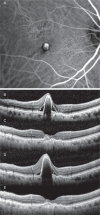Effect of switching therapy to pegaptanib in eyes with the persistent cases of exudative age-related macular degeneration
- PMID: 25319441
- PMCID: PMC4616293
- DOI: 10.1097/MD.0000000000000116
Effect of switching therapy to pegaptanib in eyes with the persistent cases of exudative age-related macular degeneration
Abstract
Purpose of this study was to evaluate the efficacy of switching to pegaptanib monotherapy for persistent cases of exudative age-related macular degeneration (AMD).Out of 296 eyes of 296 patients treated with ranibizumab or ranibizumab combined with photodynamic therapy (PDT), 50 eyes of 50 AMD patients were found to be resistant to these treatments. Over a 12-month period, intravitreal pegaptanib (IVP) 0.3 mg was administered at intervals of 6 weeks until the exudation disappeared prospectively. All patients were examined with the following tests: best-corrected visual acuity (BCVA) and central retinal thickness (CRT), determined at the initial visit, before the first IVP (baseline), and at 12 months. The factors responsible for achieving dry macula with IVP were examined statistically.The rate of persistent cases with intravitreal ranibizumab (IVR) and/or PDT was 17.0%. The mean number of IVPs administered was 5.4 (range, 2-9). Logarithm of the minimal angle of resolution BCVA at 12 months was stable or improved by ≥ 0.3 in 49 eyes (98.0%), with a significant improvement noted between the baseline and final BCVA (P=0.01, paired t test). The CRT (mean ± standard deviation) was 446.9 ± 150.6 µm at the initial visit, 414.5 ± 146.5 µm at baseline, and 318.7 ± 99.0 µm at 12 months. There was a significant decrease in the mean CRT between the measurements at baseline and at 12 months after the first IVP (P=0.002, Bonferroni correction). At 12 months, the exudative change was completely resolved in 27 eyes (54.0%) and reduced in 21 eyes (42.0%). The number of previous IVR treatments was significantly correlated with dry macula at 12 months.After switching therapy to pegaptanib in persistent cases of AMD, most patients maintained or improved their BCVA and exhibited a positive treatment response at 12 months.
Conflict of interest statement
The authors have no funding to disclose.
The authors have no proprietary interest in any aspect of this study.
Figures





Similar articles
-
Serous pigment epithelial detachment in age-related macular degeneration: comparison of different treatments.Eye (Lond). 2009 Dec;23(12):2163-8. doi: 10.1038/eye.2008.425. Eye (Lond). 2009. PMID: 19197318
-
Variable response of vascularized pigment epithelial detachments to ranibizumab based on lesion subtypes, including polypoidal choroidal vasculopathy.Retina. 2013 May;33(5):990-7. doi: 10.1097/IAE.0b013e3182755793. Retina. 2013. PMID: 23446653
-
Treatment of neovascular age-related macular degeneration with a variable ranibizumab dosing regimen and one-time reduced-fluence photodynamic therapy: the TORPEDO trial at 2 years.Graefes Arch Clin Exp Ophthalmol. 2010 Jul;248(7):943-56. doi: 10.1007/s00417-009-1256-6. Epub 2010 Mar 4. Graefes Arch Clin Exp Ophthalmol. 2010. PMID: 20204659 Clinical Trial.
-
[Intravitreal ranibizumab in combination with verteporfin photodynamic therapy in neovascular macular degeneration].Cesk Slov Oftalmol. 2008 Jul;64(4):135-40. Cesk Slov Oftalmol. 2008. PMID: 18780651 Clinical Trial. Czech.
-
Visual outcome of intravitreal ranibizumab for exudative age-related macular degeneration: timing and prognosis.Clin Interv Aging. 2014;9:141-5. doi: 10.2147/CIA.S56863. Epub 2014 Jan 10. Clin Interv Aging. 2014. PMID: 24453484 Free PMC article.
Cited by
-
Recent perspectives on the delivery of biologics to back of the eye.Expert Opin Drug Deliv. 2017 May;14(5):631-645. doi: 10.1080/17425247.2016.1227783. Epub 2016 Sep 6. Expert Opin Drug Deliv. 2017. PMID: 27573097 Free PMC article. Review.
-
Tachyphylaxis during treatment of exudative age-related macular degeneration with aflibercept.Graefes Arch Clin Exp Ophthalmol. 2019 Nov;257(11):2559-2569. doi: 10.1007/s00417-019-04456-2. Epub 2019 Sep 3. Graefes Arch Clin Exp Ophthalmol. 2019. PMID: 31482277
-
Asymmetric response to ranibizumab in mixed choroidal neovascularization in a neovascular age-related macular degeneration diagnosed on OCT angiography - case report.BMC Ophthalmol. 2021 Jan 15;21(1):42. doi: 10.1186/s12886-021-01810-z. BMC Ophthalmol. 2021. PMID: 33451290 Free PMC article.
-
Clinical pharmacology of intravitreal anti-VEGF drugs.Eye (Lond). 2018 Jun;32(6):1010-1020. doi: 10.1038/s41433-018-0021-7. Epub 2018 Feb 5. Eye (Lond). 2018. PMID: 29398697 Free PMC article. Review.
-
Response to Aflibercept Therapy in Three Types of Choroidal Neovascular Membrane in Neovascular Age-Related Macular Degeneration: Real-Life Evidence in the Czech Republic.J Ophthalmol. 2019 Jun 10;2019:2635689. doi: 10.1155/2019/2635689. eCollection 2019. J Ophthalmol. 2019. PMID: 31316822 Free PMC article.
References
-
- Apte RS, Modi M, Masonson H, et al. ; Macugen AMD Study Group. Pegaptanib 1-year systemic safety results from a safety-pharmacokinetic trial in patients with neovascular age-related macular degeneration. Ophthalmology. 2007;114:1702–1712. - PubMed
-
- Rosenfeld PJ, Brown DM, Heier JS, et al. Ranibizumab for neovascular age-related macular degeneration. N Engl J Med. 2006;355:1419–1431. - PubMed
-
- Boyer DS, Antoszyk AN, Awh CC, et al. ; MARINA Study Group. Subgroup analysis of the MARINA study of ranibizumab in neovascular age-related macular degeneration. Ophthalmology. 2007;114:246–252. - PubMed
Publication types
MeSH terms
Substances
LinkOut - more resources
Full Text Sources
Other Literature Sources
Medical
Research Materials

